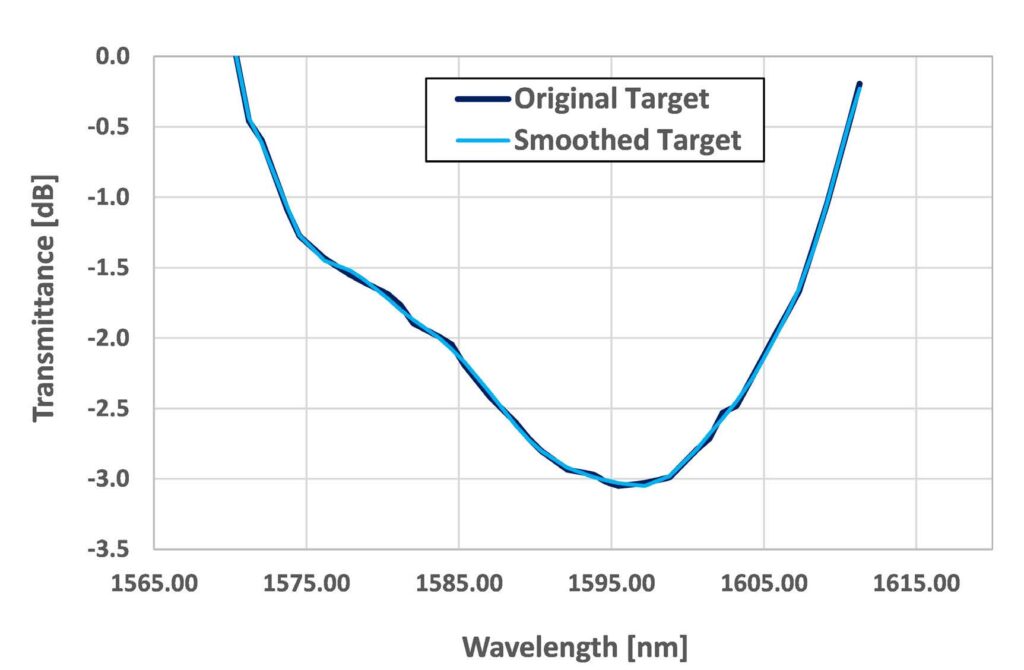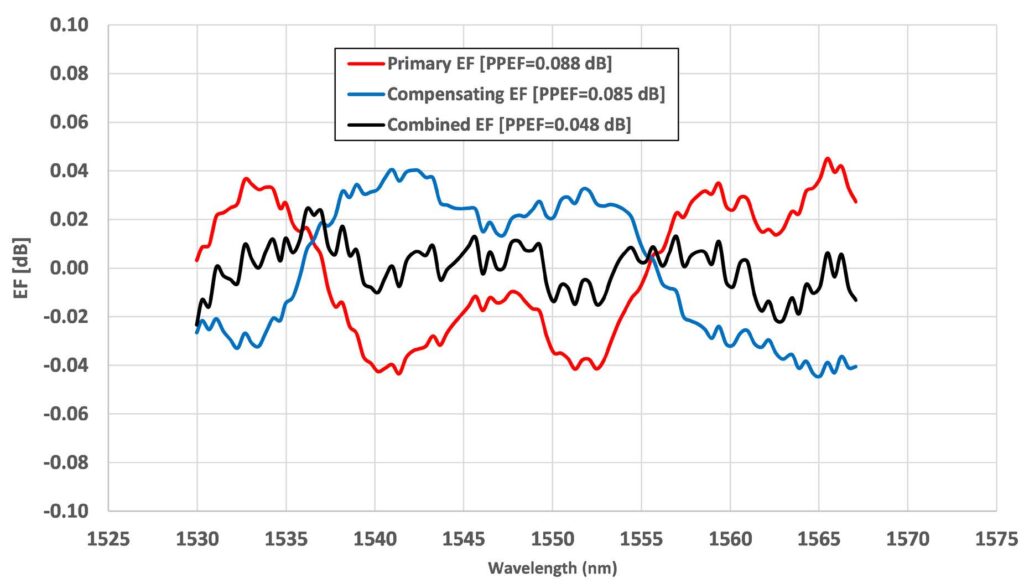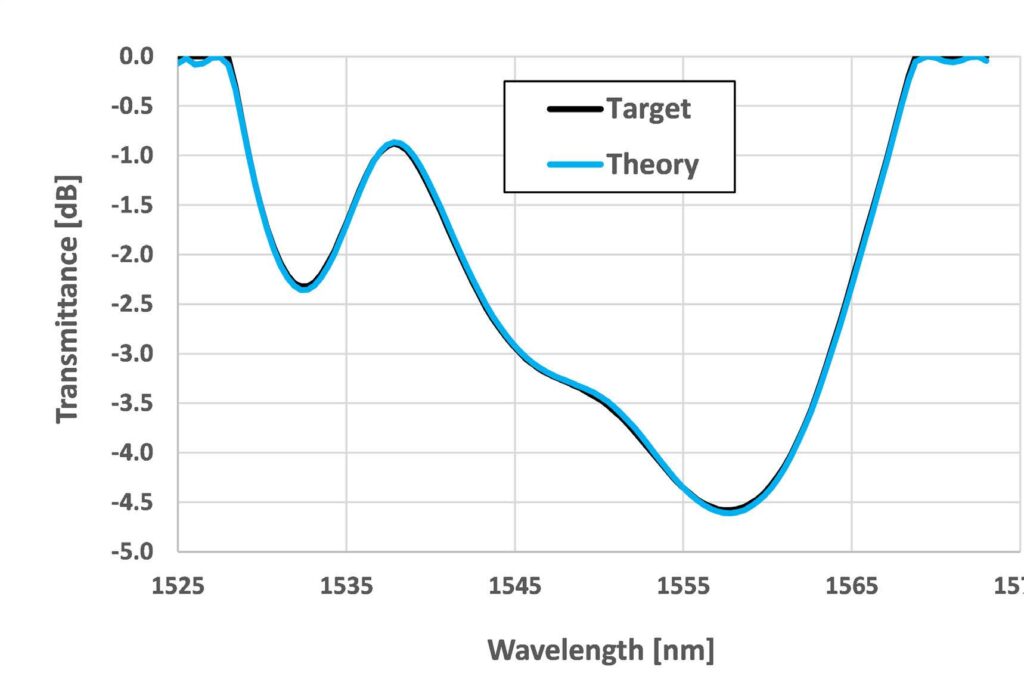Iridian’s premium GFFs deliver higher-level performance than traditional GFFs to meet stringent PPEF specifications, as well as provide additional functionality.
By Xiaolun Zeng and Michelle Derouin, Iridian Spectral Technologies
Gain flattening filters (GFFs), used to smooth out (i.e., “flatten”) unequal signal intensities over a specified wavelength range, have evolved significantly over the past 20 years. While the packaging and materials utilized to construct these components have remained almost unchanged, advances including improved coating processes and optimized manufacturing uniformity have pushed GFF performance to new heights.
More advanced, modern GFFs take advantage of designers’ ability to exert greater control over peak-to-peak error function (PPEF) — calculated by comparing the spectral performance of the manufactured filter to a client’s target gain curve specification — and can be promoted with higher level performance and imbued with additional functionality. For example, some applications require multiple flattening regions or the addition of a passband outside the flattening region.
The slightest advantage in GFF performance or functionality can have huge implications for designers of erbium-doped fiber amplifier (EDFA) modules. While variation of signal intensity is unavoidable, EDFA module designers must reduce that intensity difference to meet the specifications demanded by their own customers. If the filters they use (e.g., GFFs) do not facilitate an error function (EF) spec within the customer’s range, the EDFA designer is challenged to tighten parameter tolerance control in their packaging to correct the signal intensity variation.
For example, if the module designer’s EF budget for an EDFA is 1 dB, they must determine how that budget will be shared across components in the unit. If a GFF vendor can provide a filter (or a series of filters) with 0.5 dB EF, the EDFA module designer has 0.5 dB EF to work with throughout the rest of the system. But, if the GFF vendor provides a filter achieving 0.2 dB EF, the EDFA designer now has a 0.8 dB EF budget to work with across the rest of the system. It is with these razor-thin margins in mind that Iridian Spectral Technologies has developed its latest generation of premium GFFs.
Optimizing GFF Performance and Functionality
Iridian can accomplish customer goals in several different ways, whether they engage us for input on what we can provide before designing their EDFA module or approach us with precise specification needs after the module has been designed. For example, in the latter scenario, we are able to help correct the customer’s target curve.
Data for the curve, based on the customer’s EDFA gain spectrum, usually is measured directly from the erbium fiber. Sometimes, significant measurement deviation is present on the curve, rendering it noisy (i.e., erratic and bumpy). Noisy GFF target data can make achieving a low PPEF difficult because the modulation depth and steepness of the GFF target can restrict how low the PPEF specification can be.
This noisy curve is the result of errors in the measurement process and thus is not truly representative of the EDFA’s performance. Theoretically, erbium fiber performance should be smooth. In these cases, before we send the customer a GFF design, Iridian has the experience and technical capability to smooth the target curve, bringing it closer to its theoretical optimization and the client’s intent (Fig. 1). 
Fig. 1 — Example of applying smoothed fitting curve in simulation to correct an original target curve measured from EDFA with system noise.
Additionally, Iridian has the ability to deftly compensate the EF in GFFs. By designing and producing a filter set with opposite error functions, we can reduce the combined PPEF. Stated differently, we can produce a filter with a precise error function, and then compensate for that error function to cancel it out by using a pair of filters, achieving lower overall PPEF throughout the system.
Consider a single GFF filter with a PPEF spec of 0.1 dB. Combining these filters should result in a 1-1 PPEF < 0.1 X n dB (with “n” representing the number of filters). For example, this GFF filter is applied to an EDFA requiring 10 stages of amplification (and, by extension, multiple stages of error function). If 10 GFF filters with a PPEF spec of 0.1 dB are series connected to the EDFA, the accumulated EF becomes 1 dB. However, the added GFFs compensate for the increasing error function, and the reading should be below 1 dB. Ultimately, this leads to a final EF curve that is less pronounced (Fig. 2).
Fig. 2 — A PPEF compensation example showing the measured EF of a primary GFF (red) and a compensating GFF (blue), as well as their combined performance (black). The example depicted is equivalent to passing through n=2 optical repeaters.
Iridian also can help customers seeking to create a passband on the edge of the target curve, maintaining high transmission outside the gain-flattened region for signal carrying or other purposes. A more traditional GFF curve is smoother on the edges, whereas extending the GFF wavelength branches the curve slightly on either side or both sides (i.e., the lower wavelength side and the higher wavelength side), per the customer’s needs. These sharper curves, sometimes referred to as “wings,” then become flat in the desired spot (Fig. 3). These edges are very small, often only a few nanometers, but it is difficult for most GFF filter providers to accomplish.
Finally, Iridian customers who want to save on space by reducing the number of filters in an EDFA can combine the functionality of a GFF and a wavelength division multiplexer (WDM) filter by using a hybrid filter (a subset of our premium filters). In hybrid GFF design, Iridian can optimize the transit band limitation between the GFF curve band and blocking bands out of GFF range (learn more about hybrid GFFs and their capabilities here).
Fig. 3 — A GFF target curve with “wings.” Adding extended wings on both GFF curve sides optimizes the performance of “edge channels” operating within that wavelength range in the EDFA module.
Final Thoughts
EDFA applications vary greatly, but size, weight, and power concerns, as well as cost (SWaP-C) generally dominate module design. Iridian has the experience and expertise to help our customers meet even the most stringent SWaP-C demands by providing premium GFFs with high PPEF performance that ease overall module design.
Whether you want to take on combined EF yourself — building an EDFA, calculating its EF, and then implementing GFFs — or you want to collaborate, building an EDFA with our filters implemented into the design up-front, Iridian can help. We continually seek to improve our design and manufacturing processes to reduce costs for our customers, as well as maintain high throughput yields even at a tight EF. Moreover, we exercise precise control from coating run to coating run, ensuring the high-quality result is repeatable. For more information, contact the authors and explore the links below.
Additional Resources
https://www.iridian.ca/product-category/telecom-filters/gain-flattening/
https://www.iridian.ca/product/hybrid-gff-with-extended-pass-band/
https://www.iridian.ca/technical-resources/optical-filter-tutorials/gain-flattening-filter-gff-tutorial/
About The Authors
Xiaolun Zeng has a B.ENg in Automation Technology, an MSc. in Applied information and Computer Science, as well as more than 20 years’ experience assisting customers with a wide range of technology needs for telecommunications applications. Prior to joining Iridian in 2005, Xiaolun served as R&D and sales & marketing manager at Broadex; he also served in senior engineering, product development, and sales roles at AFOP, Santec, and JDS Uniphase. As Product Group Manager – Telecom at Iridian, Xiaolun assists our telecom customers with optical filter solutions.
Michelle Derouin received her BASc in Electrical Engineering at Queen’s University in 2005 and is a Senior Application Engineer at Iridian Spectral Technologies, where she brings over 15 years’ experience in optical filter design. Michelle specializes in telecom filter design — gain flattening filters and dual band filters, in particular. Her skills and abilities in these areas have translated to a variety of product lines, including 3D cinema production.
About Iridian Spectral Technologies
Iridian Spectral Technologies is a world leader in the design and manufacture of custom optical filter solutions. Using advanced, proprietary thin-film design deposition and manufacturing technology, Iridian delivers durable, high-performance optical filters for use in applications including telecommunications and data centers, Raman and fluorescence spectroscopy, mid IR gas sensing, satellite-based imaging and communications, and many more.




